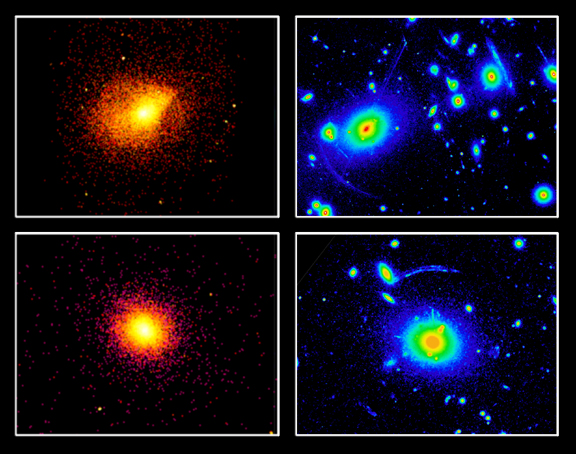Credit: S. Allen (IoA Cambridge) et al.,
NASA
Explanation:
Situated over 2,000,000,000 (two billion)
light-years from Earth, galaxies in cluster Abell 2390 (top) and
MS2137.3-2353 (bottom)
are seen in the right hand panels above,
false-color images from the
Hubble
Space Telescope.
Corresponding panels on the left reveal each cluster's
x-ray
appearance in images from the Chandra X-ray Observatory.
While the Hubble images record the cluster's star-filled galaxies,
the x-ray images show no galaxies at all ... only
multi-million degree hot intracluster gas
which glows in high energy x-rays.
But there lies a profound mystery.
The total mass in the galaxies on the right, plus the
mass of the hot gas on the left, falls far short of providing enough gravity
to confine the hot gas within
the galaxy clusters.
In fact,
the best accounting to date
can only find 13 per cent (!)
of the total matter necessary.
Gravitational lens
arcs visible in the deep Hubble images
also indicate these clusters have much more mass than directly identifiable
in the Chandra and Hubble data.
Astronomers conclude that most of the cluster matter is
dark matter,
invisible even to the combined far-seeing eyes of these orbiting
astrophysical observatories.
What is the
nature of this cosmic dark matter?
Tomorrow's picture: Mars Odyssey
1999 2000 2001 2002 2003 2004 2005 2006 2007 2008 2009 2010 2011 2012 2013 2014 2015 2016 2017 2018 2019 2020 2021 2022 2023 2024 2025 |
Yanvar' Fevral' Mart Aprel' Mai Iyun' Iyul' Avgust Sentyabr' Oktyabr' Noyabr' Dekabr' |
NASA Web Site Statements, Warnings, and Disclaimers
NASA Official: Jay Norris. Specific rights apply.
A service of: LHEA at NASA / GSFC
& Michigan Tech. U.
|
Publikacii s klyuchevymi slovami:
galaxy cluster - abell 2390 - dark matter - temnaya materiya - rentgenovskoe izluchenie - Skoplenie galaktik
Publikacii so slovami: galaxy cluster - abell 2390 - dark matter - temnaya materiya - rentgenovskoe izluchenie - Skoplenie galaktik | |
Sm. takzhe:
Vse publikacii na tu zhe temu >> | |
